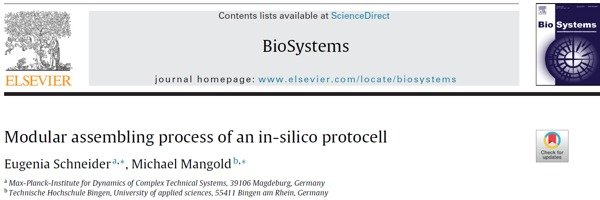
Modular assembling process of an in-silico protocell
One long-term goal of the bottom-up approach in Synthetic Biology is to form artificial protocells from single building blocks. This article covers a system theoretic approach for construction of a protocell model by the modular assembling process that is similar to the unit operation approach of Chemical Engineering. Different models for an in-silico protocell are shown in this article that combine experimentally validated and theoretical assumptions. Three functional modules serve as the basic structure for the in-silico protocell: the membrane subsystem, the contractile entity, and a positioning module. One of the models described in this article has a system-theoretic structure like shown in Fig. 1.

Figure 1. System-theoretic structure of the in-silico protocell model. The shape of the protocell is defined by the membrane module that provides the building blocks for the contractile entity. The information about the membrane geometry is transmitted to the positioner module. The positioner module forwards the information about the state of membrane binding sites to the contractile entity that influences the membrane by contractile stress and causes the membrane shape change.
The membrane module gives the information about the membrane geometry to the positioner module. In addition, the membrane module provides the building blocks of the contractile entity. By a wavelike occupation of the membrane binding sites by the positioner module the membrane area is defined where the generated building blocks of the contractile entity can attach and constrict the membrane. The modular character of this model has the benefit of the possibility to exchange one functional module without changing the functionality of the other modules.
Different hypothetical assumptions for developing a protocell model are shown in this article which can be helpful for the realization of protocell construction. Depending on the requirement of more or less complex model and the goal one can use the appropriate modeling approach.
Article link: Biosystems 165, pp. 8 - 21 (2018)
More publications from MaxSynBio in our publication list.
